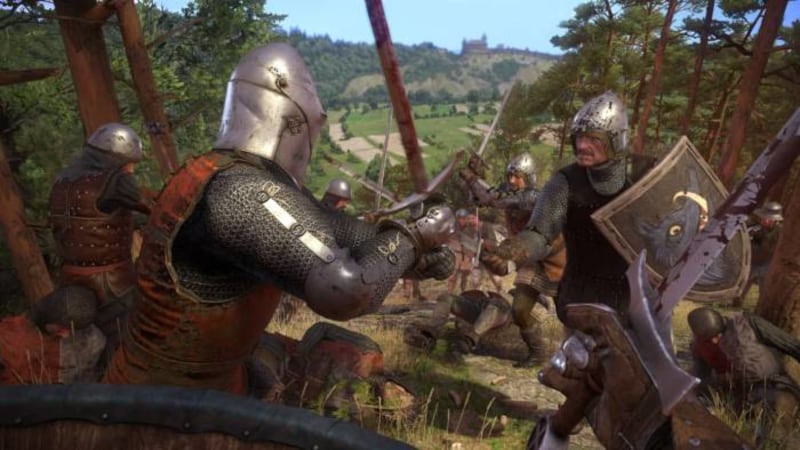The Middle Ages was a long, and very diverse period of history, stretching arbitrarily from the fall of Rome to the re-discovery of America.
It’s also a time which lives in a hundred movies, novels, and pieces of art, some of them accurate, some of them less so, all contributing to a certain vision of Medieval Europe.
In the list below we’ve gathered a number of video games that share the Medieval theme but approach it differently. Some are set firmly in the real world and try to stay quite historically accurate, while others simply use the period as a basis or aesthetic for their fictional worlds. Either way, there’s always more than just a hint of the Middle Ages present in all games presented below.
| Game | Release | Genre | Developer | |
|---|---|---|---|---|
 | Medieval Dynasty | 2020-09-17 | Simulation | Render Cube |
 | Mordhau | 2019-04-29 | Indie | Triternion |
 | Kingdom Come Deliverance | 2018-02-13 | Adventure | Warhorse Studios |
 | Chivalry Medieval Warfare | 2012-10-16 | Action & Shooter | Torn Banner Studios |
 | For Honor | 2017-02-13 | Action & Shooter | Blue Byte |
 | Darkest Dungeon | 2016-01-19 | Indie | Red Hook Studios |
 | Dragon Age Origins | 2009-11-06 | Action & Shooter | BioWare |
 | Mount Blade Warband | 2010-03-31 | Adventure | TaleWorlds Entertainment |
 | A Plague Tale Innocence | 2019-05-14 | Adventure | Asobo Studio |
 | The Elder Scrolls V Skyrim | 2016-10-27 | Adventure | Bethesda Game Studios |
 | The Witcher 3 Wild Hunt Goty Edition | 2015-05-18 | RPG | CD PROJEKT RED |
 | Assassin's Creed Ubisoft Connect | 2008-04-09 | Adventure | Ubisoft Montreal |
 | Age Of Empires II Hd | 2013-04-09 | Strategy | Ensemble Studios |
 | Crusader Kings II Collection 2014 | 2012-02-14 | Strategy | Paradox Development Studio |
 | Medieval II Total War Collection | 2006-11-15 | Strategy | Feral Interactive (Linux) |
 | Stronghold Crusader HD | 2002-07-31 | Simulation | FireFly Studios |
 | Medieval Total War Collection | 2002-08-20 | Strategy | Creative Assembly |
 | Stronghold Crusader 2 | 2014-09-22 | Simulation | FireFly Studios |
Age of Empires II
| Release year: | 1999, 2013 (HD Edition) |
| Genre: | Real-time strategy |
| Developer | Ensemble Studios, Hidden Path Entertainment (HD Edition) |
| Historicity | Anachronistic, but with real civilizations |
The base Age of Empires features 13 civilizations taken from all over the world, including the Japanese, Persians, and Saracens, as well as European nations, such as the Norse (Vikings), or Franks.
Between the original release and the HD Edition, three expansions were released, adding a dozen or so civilizations such as the Aztecs, Slavs, Berbers, or the Vietnamese.
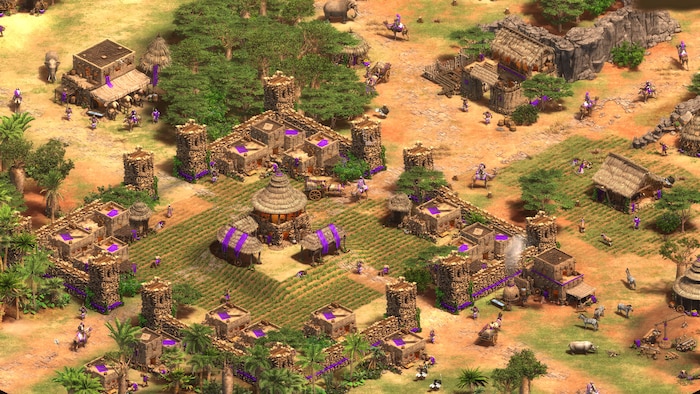
Each civilization not only has unique units, but also a Wonder, a building iconic for the given nation. The castles and other buildings also have distinctive architecture. The series isn’t historically accurate for the most part, but it does a decent job portraying certain elements of the civilisations going through the eras from the fall of Rome to the late Middle Ages. Even if the Aztecs can fight Vikings.
| Key features |
|---|
|
Assassin’s Creed
| Release year: | 2007 |
| Genre: | Action-adventure, stealth |
| Developer | Ubisoft Montreal |
| Historicity | Historical figures and locations linked by a fictional storyline |
The original AC downplayed the weird in favor of letting you soak in the atmosphere of the crusades-era Holy Land.
There are three cities in the game: Jerusalem, Acre, and Damascus, and you get to explore them as well as the areas between them, and the stronghold of the Assassins. Although the game is over a decade old now, the sightseeing it offers remains quite remarkable.
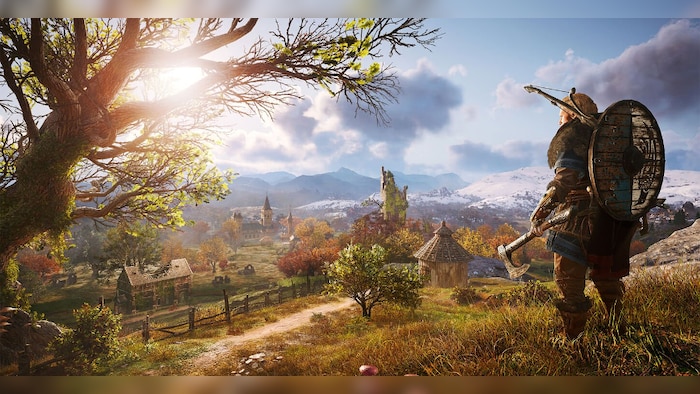
The year is 1191, and these cities are full of European knights and common soldiers, of white-robed monks, and local people plying their trades. Although the simulations got more advanced in future installments of the series, it took AC: Valhalla for the series to go back to the Middle Ages, but to a different time and a very different place. The original AC remains a great medieval sightseeing trip.
| Key features |
|---|
|
Chivalry: Medieval Warfare
| Release year: | 2012 |
| Genre: | Hack and slash |
| Developer | Torn Banner Studios |
| Historicity | Historical weapons, armor, and structures; fictional setting |
Although Chivalry: Medieval Warfare does have some backstory speaking of a conflict between nations, it isn’t particularly important, as the game has an undeniable PvP focus.
But that doesn’t affect its Medieval aspects, however, because there are plenty of melee weapons and armor pieces from all over the Middle Ages and into the Renaissance.

Players get to pick a class, of which there are four (Archer, Man-at-Arms, Vanguard, Knight), and that defines the equipment available. It won’t teach you history, or historical European martial arts, but it does a good job showing off many different kinds of weapons and armor from the period, and that isn’t anything to sneeze at. And, above all, it’s a very enjoyable PvP game for fans of swords and shields.
| Key features |
|---|
|
Crusader Kings II
| Release year: | 2012 |
| Genre: | Grand strategy, role-playing |
| Developer | Paradox Development Studio |
| Historicity | Takes place in Medieval Europe, but campaigns aren’t scripted |
There probably is no greater simulation of Medieval dynastic politics than the Crusader Kings series.
Until the launch of CK3 in 2020, Crusader Kings II reigned supreme, having accumulated expansions, and an unholy number of community mods. CK2 sits comfortably between being a grand strategy in that you run one of the European powerhouses, but also make personal decisions as it head.
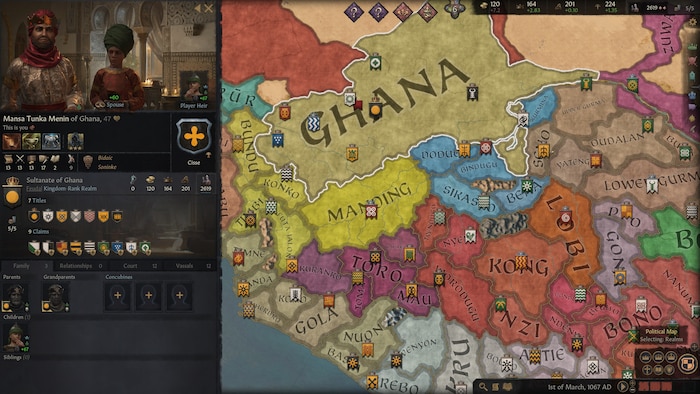
If this list has one game that does an outstanding job conveying how crazy and volatile were Medieval dynastic relations, it’s this one. Incest, betrayal, murder, denouncements, and heresy, it’s all in here. No wonder there are mods turning Crusader Kings II into A Song of Ice and Fire adaptation. Be aware, however, that it’s a very complex game, not necessarily the easiest to get into.
| Key features |
|---|
|
Darkest Dungeon
| Release year: | 2016 |
| Genre | Role-playing, dungeon crawl |
| Developer | Red Hook Studios |
| Historicity | Takes inspiration from the Middle Ages, but is set in a fantasy world |
Darkest Dungeon, among other things, is famous for the Lovecraftian horrors slithering through the mouldy corridors of its eldritch dungeons, threatening the safety of mortals eager to delve into their depths.
What isn’t talked about all that much is how many classes are steeped in the cultural miasma of the Middle Ages. Hint: quite a few. And it makes the game even more gritty.
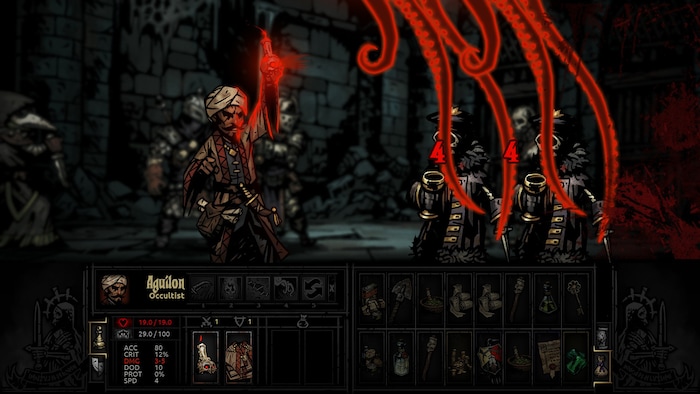
There’s a crusader, inspired by Raynald of Châtillon, Leper inspired by Baldwin IV of Jerusalem, there’s a Man-at-Arms, and a Plague Doctor with the iconic beak mask. While historically the Middle Ages weren’t quite as dark as Darkest Dungeon, the game’s inspiration is undeniably rooted in the Medieval history and culture. And, above all, it’s an outstanding, deeply engaging game.
| Key features |
|---|
|
Dragon Age Origins
| Release year: | 2009 |
| Genre: | Role-playing |
| Developer | BioWare |
| Historicity | Mostly in the aesthetic and atmosphere |
The original Dragon Age, subtitled “Origins” was a very down-to-earth game, far from the excesses of Inquisition which leaned more towards high fantasy.
DAO certainly lends itself to a certain vision of the Middle Ages as a dark time with few colours and generally drab existence. It certainly supports the dark storyline of the game, full of political maneuvering and monstrous enemies.
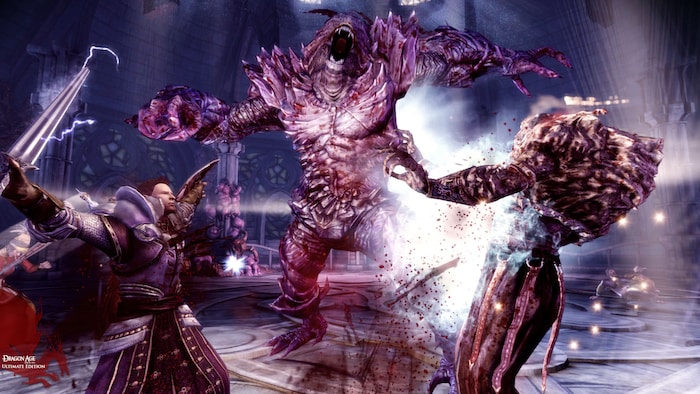
Dragon Age games don’t have much by way of educational value, but they teem with the medieval atmosphere even as the story takes the player to magic towers and sprawling underground cities fighting against ravenous monsters. It lies somewhere between A Song of Fire and ice and Lord of the Rings, especially their TV and cinematic adaptions. It’s a solid old school-feeling RPG.
| Key features |
|---|
|
For Honor
| Release year: | 2017 |
| Genre: | Action, fighting |
| Developer | Ubisoft Montreal |
| Historicity | Champions are inspired by warriors from history and culture |
For Honor is like a game based on old Internet forum discussions about which historical warriors were more deadly. Ubisoft’s fighting game has that play out across, at present, four factions.
There are Knights, Vikings, Samurai, and the Wu Lin inspired by European, Norse, Japanese, and Chinese fighters. The roster is wildly anachronistic, some units would be separated by centuries in real history.

Each fighter has a unique weapon and armor, some of which are quite close to their historical counterparts, others are less accurate, or taken out of context, for various reasons, like balance and rule of cool. It won’t solve the ages-old dispute of “who would win”, but it’s a great, very technical, fighting game which got a lot of weapons and armor surprisingly right when considered on their own.
| Key features |
|---|
|
Kingdom Come: Deliverance
| Release year: | 2018 |
| Genre: | Action role-playing |
| Developer | Warhorse Studios |
| Historicity | High: the region and period were extensively researched and recreated in detail |
Kingdom Come: Deliverance takes place in 1403 in Bohemia (now the territories of the Czech Republic).
Warhorse Studios took great pains to make sure they represent the reality of that time and place as accurately as possible. The architecture looks authentic, the weapons look and behave mostly as they should, and there are no outlandish designs unless they could be found in history.
The game’s protagonist is Henry, a blacksmith’s son, who early in the game survives the attack on his village. Since then he crosses paths with many historical figures and pursues his own vengeful goals. Kingdom Come: Deliverance isn’t an easy game, however, with a challenging combat system, and mechanics that wouldn’t feel out of place in survival games, such as staving off hunger.
| Key features |
|---|
|
Medieval: Total War & Medieval II: Total War
| Release year: | 2002 (MTW), 2006 (MII:TW) |
| Genre: | Turn-based strategy, real-time tactics |
| Developer | Creative Assembly |
| Historicity | Fairly historically accurate |
After the success of Shogun: Total War developer Creative Assembly decided to change the scenery from feudal Japan to Medieval Europe between 11th and 15th centuries.
Like in all Total War games, you have the turn-based strategic layer where you move armies, assign research goals, or dabble in diplomacy. When your armies clash, you move to real-time battle with hundreds of units on screen.
There are many units inspired by and taken straight out of history books, and the map is obviously based on Europe in different eras of the Middle Ages. You can also participate in historical battles and maybe try to turn their tide, changing the course of history. Both installments of Medieval: Total War are militaristic counterparts of Paradox’s Crusader kings, and just as good at what they do.
| Key features |
|---|
|
Mordhau
| Release year: | 2019 |
| Genre: | Hack ‘n slash |
| Developer | Triternion |
| Historicity | Weapons and armor are quite historically accurate in their appearance |
Mordhau is what German sword masters called grabbing the sword by its blade and attacking the opponent with the pommel or the crossguard, like a mace or a pick.
It literally translated into “murder-stroke” or “murder-blow”. And apt name for a game that’s all about fighting with Medieval (and Renaissance) weapons. And the weapons are quite well represented, and fun to use.
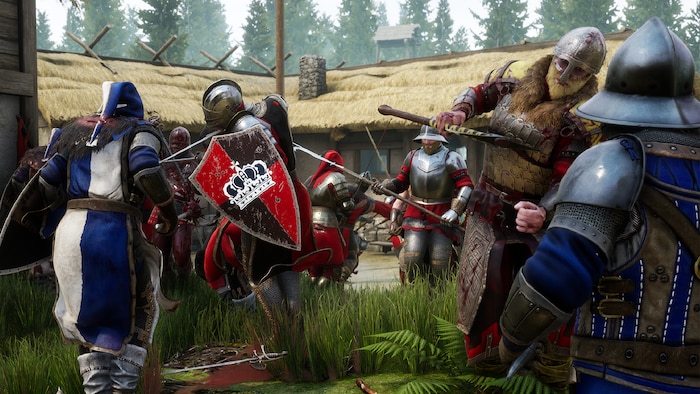
You have a certain allotment of points which you can spend on perks and equipment, so you need to decide if getting plate armour is worth not having enough points for the weapon you wanted to try, for example. There is a large number of weapon types, and you max mix and match your armour pieces freely. Nobody’s stopping you from wearing a plate helmet with a gambeson and linen trousers.
| Key features |
|---|
|
Mount & Blade: Warband & Mount & Blade II: Bannerlord
| Release year: | 2010 (Warband), 2020 (Early Access Bannerlord) |
| Genre: | Action role-playing, strategy |
| Developer | TaleWorlds Entertainment |
| Historicity | Fictional factions inspired by historical nations |
Although the Mount & Blade games take place in a fictional land of Calradia, the nations present are inspired by those from the real world.
For instance, the kingdom of Vaegirs is inspired by Russia, while the Khergit Khanate takes hints from Mongols. Each faction has unique units, such as Nord huscarls, or Rhodoks excellent crossbowmen. Most units can be neatly mapped to real world soldiers.

You come as an independent force, so you’re not only free to ally yourself with any major nation, but you can recruit from all nations to your own warband. Despite the fictional setting, walking the city streets, browsing quite authentic weaponry, and dealing with lords, vassals, and common folk makes for quite an immersive Middle Ages atmosphere, even if the series could use more colour.
| Key features |
|---|
|
Plague Tale: Innocence
| Release year: | 2019 |
| Genre: | Action-adventure, stealth, survival horror |
| Developer | Asobo Studio |
| Historicity | Set in 1348 France, but the story features supernatural elements |
The story takes place during the early years of the Hundred Years’ War, and it’s protagonist is a girl called Amicia, a young noble from Aquitaine.
When their estate is raided by Inquisition looking for Amicia’s younger brother, Hugo, the siblings need to run away and brave the world ravaged by the Bubonic Plague. It’s a dark game set during Medieval Europe’s darker periods.
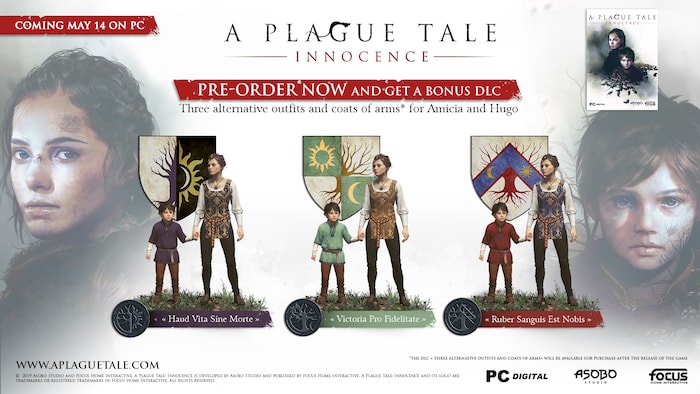
During their journey to Hugo’s doctor, Amicia will not only need to deal with human enemies, but also with rats, swarming under some dark influence. It’s a dark, gloomy story, and while the supernatural elements grow in importance over time, it’s still an interesting and dark adventure, shown from the perspective of children trying to survive against swarming rats and invading English.
| Key features |
|---|
|
The Elder Scrolls V: Skyrim
| Release year: | 2011 |
| Genre: | Action role-playing |
| Developer | Bethesda Game Studios |
| Historicity | Limited to the atmosphere and aesthetic |
Of course, Skyrim, and other Elder Scrolls games take place in a fully fantastical, fictional world, but it has a spot on this list because it has a great atmosphere.
Between dragons, magic, and dungeons, there are mead halls, inns, farms, and people just trying to get by plying their trades. Skyrim is quite obviously inspired by Scandinavia and the Norse culture. It IS TES with Vikings, after all.
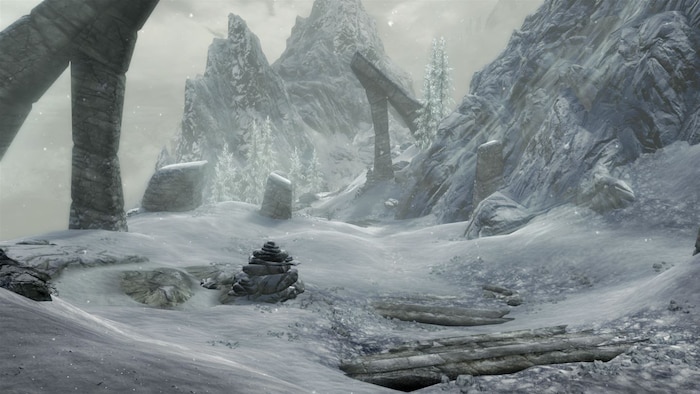
You won’t learn anything useful from playing Skyrim, of course, but it doesn’t mean it won’t scratch that itch for early-Medieval adventure, perhaps inspired by the Vikings TV show, perhaps in preparation for Assassin’s Creed Valhalla, perhaps just because it’s cool. And there’s also Skyrim’s map full of harsh beauty of frosty plains, snow-capped mountains, and small settlements on the edge of the wilderness.
| Key features |
|---|
|
The Stronghold series
| Release year: | 2001 (the original Stronghold) – 2014 (latest release: Stronghold Crusader II) |
| Genre: | Real-time strategy |
| Developer | Firefly Studios |
| Historicity | Fictional storylines, historical settings |
Stronghold is a venerable series of real-time strategy games themed around building castles and establishing flourishing infrastructures supporting their population.
Each game in the series has a separate storyline, usually within the bounds of historical fiction, but Stronghold Legends deals with myths instead, like the story of King Arthur. Mostly it adheres to historical reality, however.

One of the best features of the Stronghold games is that, depending on the mode, you have a great or greater degree of freedom in how you want to build your fortress. Of course, you’re limited by the available elements, but the layouts are up to you. Master the art of turtling, and then send your armies to breach the defenses of your enemies.
| Key features |
|---|
|
The Witcher series
| Release year: | 2007 (TW1), 2011 (TW2), 2015 (TW3) |
| Genre: | Role-playing, action role-playing |
| Developer | CD Projekt Red |
| Historicity | Fantasy setting inspired strongly by European Middle Ages |
The Witcher stories, both the original books and the games, take place in a wholly fantastical setting, but visually it’s very similar to the real world of the mid-to-late Middle Ages especially.
While Geralt himself uses mostly anachronistic, witcher-specific gear, everyone else mostly follows reality to some degree. It’s an interesting contrast between Geralt and the rest of the world.
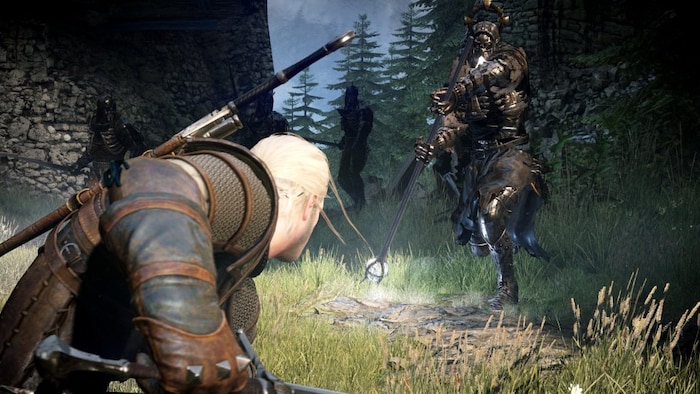
As a result you’ll see soldiers in gambesons and using polearms, common folk wears colorful clothes, and the fortifications even occasionally have machicolations (look it up). Wyzima in The Witcher 1, Flotsam and the war camps in TW2, or the Free City of Novigrad in TW3 feel like authentic places taken from history. If you don’t mind a few monsters trying to bite your face off, give the series a try.
| Key features |
|---|
|
A thousand years of history
Thus concludes the list of video games that owe a lot to the Middle Ages. Historical or fantastical, accurate or inspired by the popular perception of the age, all found their place on the list. There are, certainly, many more Medievally inclined video games out there, the ones listed above are just the strong beginning.





